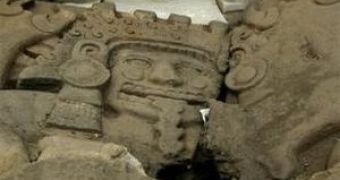It seems that the Aztec stone monolith depicting a fearsome, blood thirsty god, recently discovered in Mexico City might cover the tomb of an Aztec emperor. "It would be the first burial site ever found of a leader of the 1427-1521 Aztec empire", said archaeologist Eduardo Matos. "We think this could be a gravestone covering the place where this ruler was laid to rest," Matos said.
The stone was discovered at the foot of the western face of the ruins of Templo Mayor, the Aztecs' main religious site, found around Mexico City's main square. (see article bellow) It is thought that the Aztecs officiated rituals in Templo Mayor of cremating their leaders and burying their ashes in funerary jars.
After a month of cleansing the fractured monolith, they found beneath it a shallow pit. The god carved on the monolith is Tlaltecuhtli, goddess of earth, represented as a huge-clawed woman, with a stream of blood flowing into her mouth as she squats to give birth. In Aztec beliefs, this goddess devoured the dead and then gave them new life.
So feared was this goddess that the Aztecs used to bury depictions of her face down in the earth. But in the Templo Mayor's carving, the goddess was discovered face-up, under a layer of stone and mortar placed by the Aztecs. In her right foot claw, the goddess presents a rabbit and ten dots, in fact a date: "10 Rabbit" or 1502, the year of the death of emperor Ahuizotl (1486-1502), the father of Moctezuma, the Aztec emperor defeated by the conquistadors of Cortes.
The finding also explains the lack of Aztec imperial burials: this burial site (if it proves to be) was "hidden", being paved by the Aztecs. The Spanish people colonizing Mexico City did not notice the burial site and built houses over it, the last one collapsing in an earthquake in 1993.
The monolith has been fractured by the weight of the buildings that stood on top of it, but after total excavation it will be reassembled. The last year's accidental excavations on the edge of the site led to the location of the Templo Mayor pyramid. The Aztecs coming from Northern Mexico founded Mexico City in 1325, but their empire and conquests started with 1427.
Photo credit: Eduardo Verdugo

 14 DAY TRIAL //
14 DAY TRIAL //